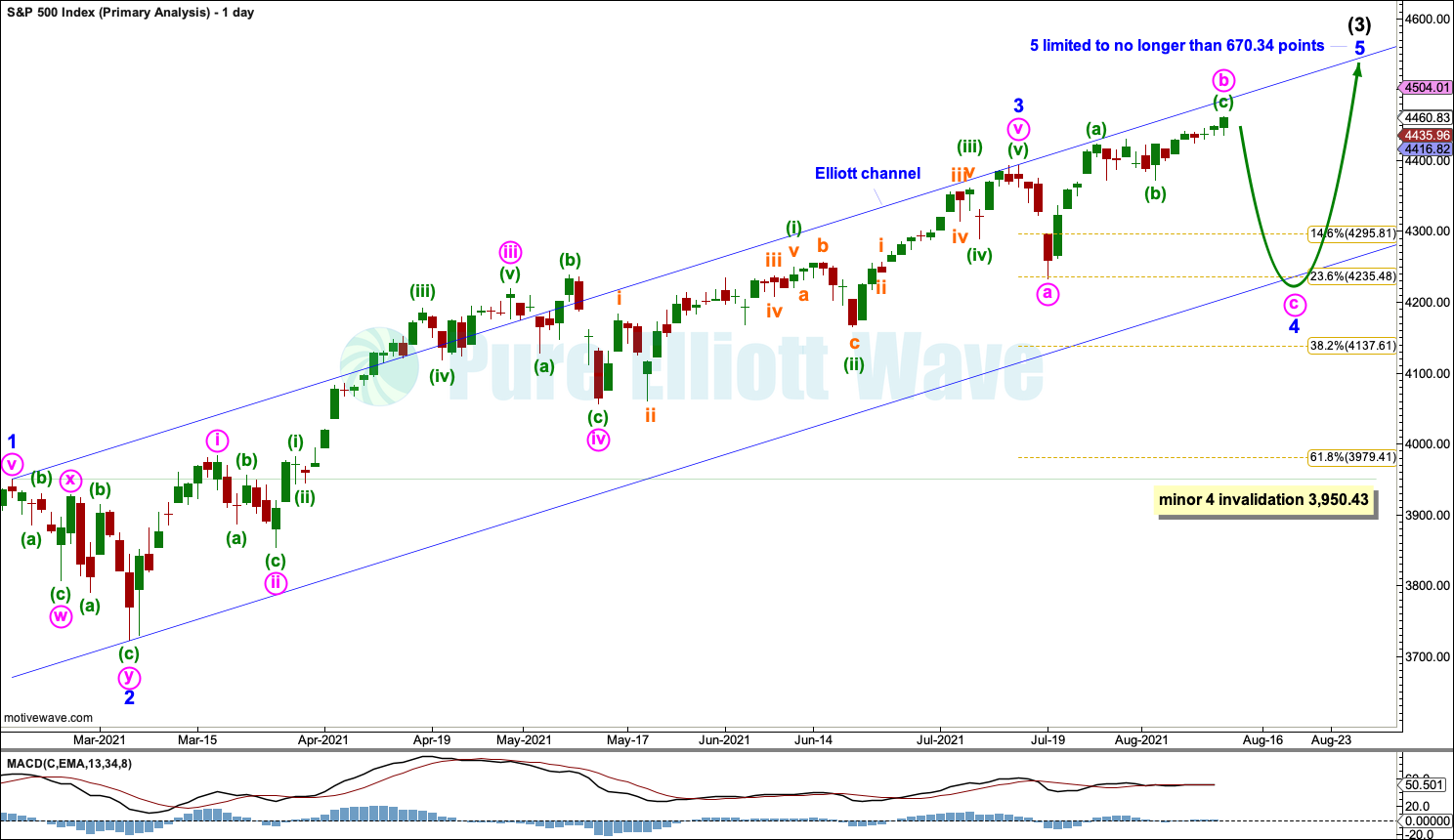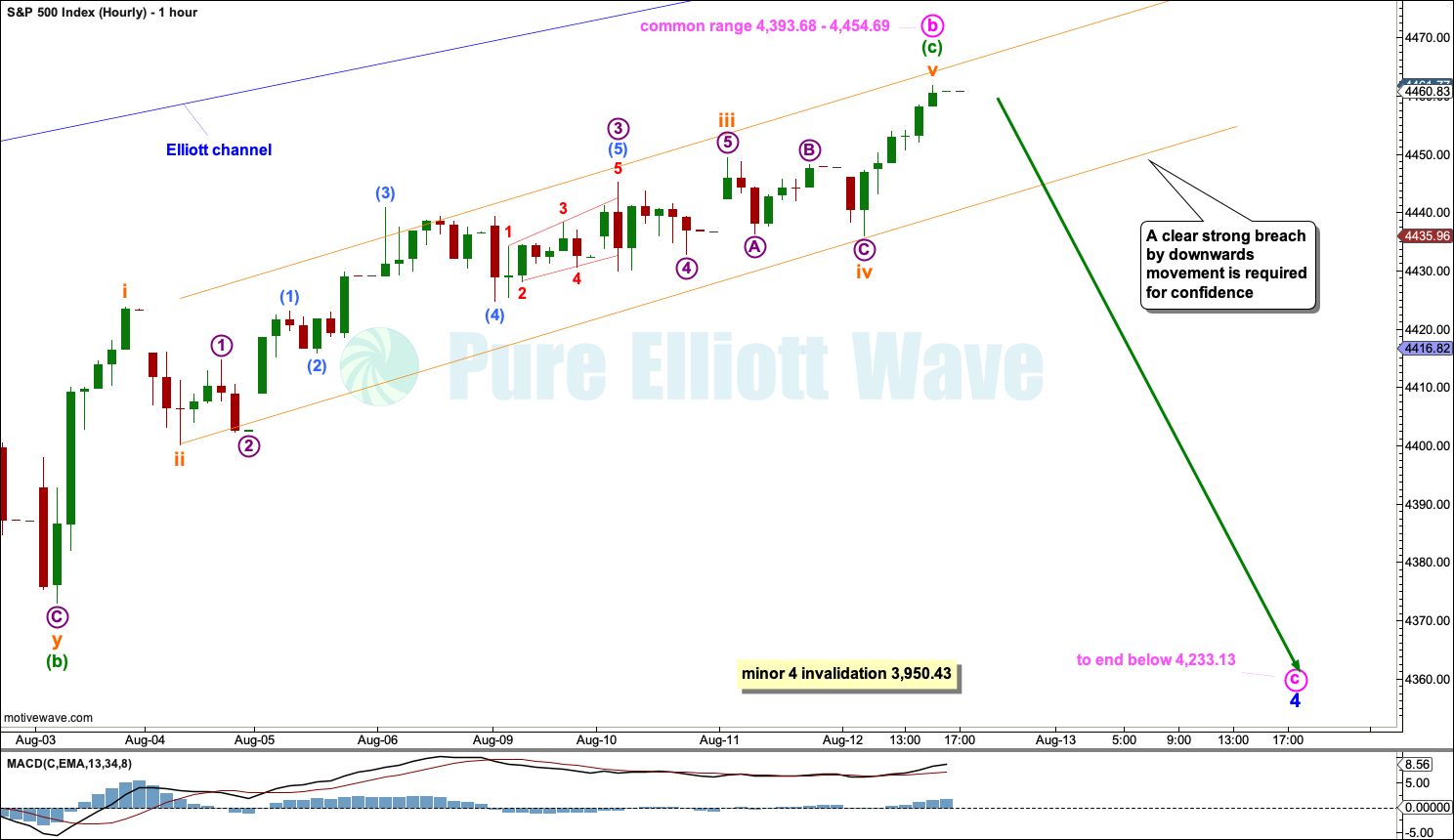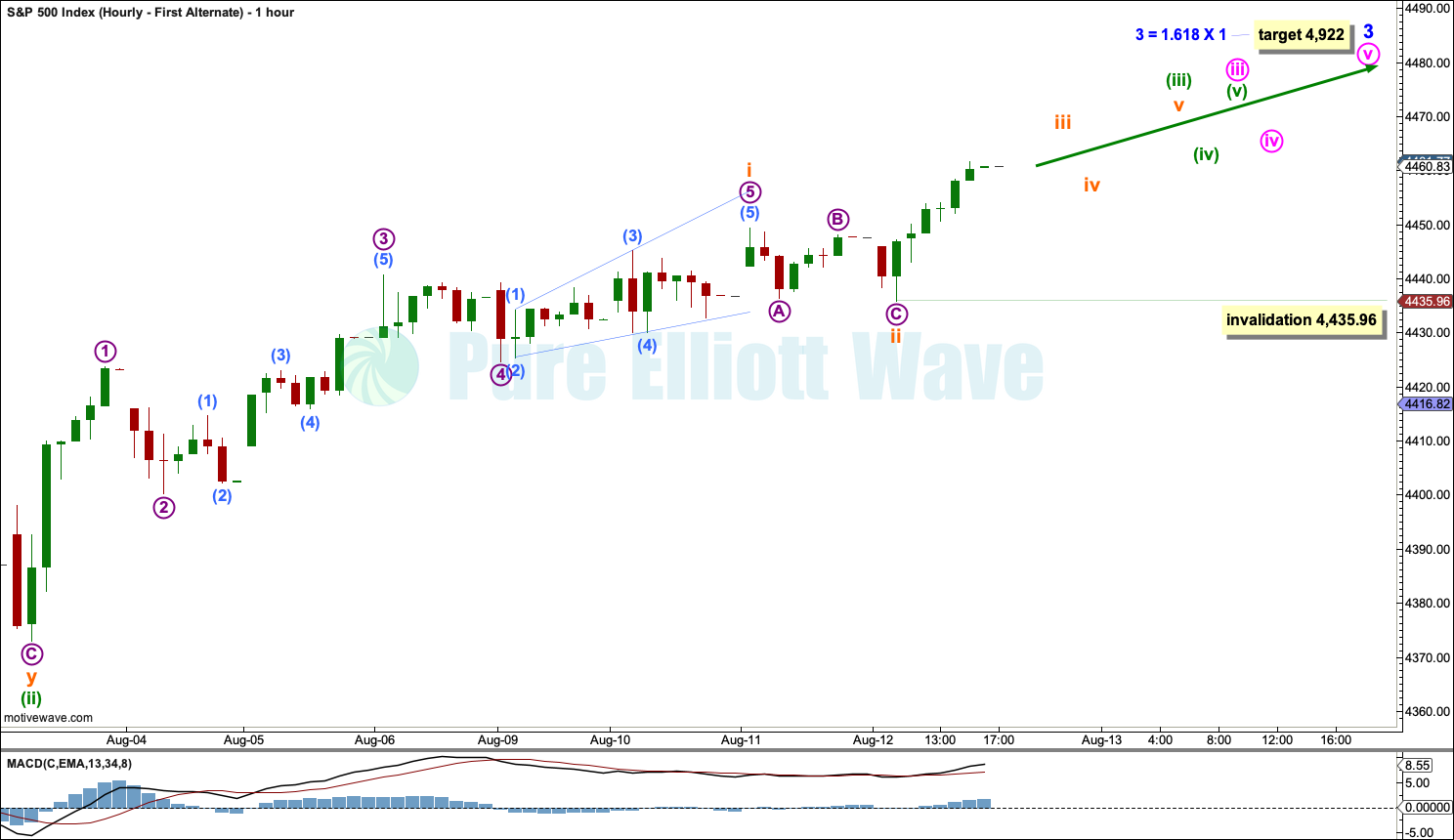S&P 500: Elliott Wave and Technical Analysis | Charts – August 12, 2021
The inclination is to switch to a bullish Elliott wave count as upwards movement continues. However, increasing bearish divergence from the AD line still suggests the main Elliott wave count, which expects a pullback here may be more likely. Both scenarios are considered in this analysis.
Summary: There is still a reasonably strong cluster of bearish signals from the AD line, but short-term weak bearish divergence between price and RSI is weakening further and is now only triple. Four Elliott wave counts are considered in order of probability:
1 – A minor degree fourth wave may continue for another two to three weeks. A downwards swing may begin tomorrow or very soon. The minimum expectation is for it to end below 4,233.13.
2 – The upwards trend has resumed to the next target at 4,922 (first alternate).
3 – An intermediate degree fourth wave on the weekly chart may move suddenly lower to find support about the lower edge of the Elliott channel, which sits about 3,956 (second alternate).
4 – A primary degree second wave may begin. It may meet the technical definition of a bear market in that it may correct to 20% or more of market value at its eventual low. Also, it may find support about 3,044 and may not make a new low below 2,191.86 (third alternate – highly unlikely now).
The biggest picture, Grand Super Cycle analysis, is here.
Monthly charts are last updated here with video here.
MAIN ELLIOTT WAVE COUNT
WEEKLY CHART
Cycle wave V may last from one to several years. So far it is in its seventeenth month.
This wave count may allow time for the AD line to diverge from price as price makes final highs before the end of the bull market. The AD line most commonly diverges a minimum of 4 months prior to the end of a bull market. A longer divergence is positively correlated with a deeper bear market. A shorter divergence is positively correlated with a more shallow bear market. There is now only eighteen days of divergence.
A longer divergence between price and the AD line would be expected towards the end of Grand Super Cycle wave I.
It is possible that cycle wave V may continue until 2029, if the 2020s mirror the 1920s. Either March or October 2029 may be likely months for the bull market to end.
Cycle wave V would most likely subdivide as an impulse. But if overlapping develops, then an ending diagonal should be considered. This chart considers the more common impulse.
There is already a Fibonacci ratio between cycle waves I and III within Super Cycle wave (V). The S&P500 often exhibits a Fibonacci ratio between two of its actionary waves but rarely between all three; it is less likely that cycle wave V would exhibit a Fibonacci ratio. The target for Super Cycle wave (V) to end would best be calculated at primary degree, but that cannot be done until all of primary waves 1, 2, 3 and 4 are complete.
Primary wave 1 within cycle wave V may be incomplete. This gives a very bullish wave count, expecting a long duration for cycle wave V which has not yet passed its middle strongest portion.
Within primary wave 1: Intermediate waves (1) and (2) may be complete, and intermediate wave (3) may now be approaching an end.
Intermediate wave (4) may not move into intermediate wave (1) price territory below 3,588.11.
Within intermediate wave (3), minor waves 1, 2 and 3 may be complete. Minor wave 3 may be shorter than minor wave 1 by 70.64 points. This limits minor wave 5 to no longer than equality in length with minor wave 3. Minor wave 4 may not move into minor wave 1 price territory below 3,950.43.
A best fit channel is drawn about cycle wave V. Draw the first trend line from the end of intermediate wave (1) to the end of minute wave iii within minor wave 3, then place a parallel copy on the end of intermediate wave (2). The channel may need to be redrawn as price continues higher. The channel may show where price may find resistance and support along the way up.
DAILY CHART
Minor wave 2 subdivided as a double zigzag and lasted 12 sessions. Minor wave 4 may last about 3 to 6 weeks and may most likely subdivide as a flat, triangle or combination, which are often longer lasting than zigzags. Flats, triangles or combinations are choppy sideways movements with swings from resistance to support and back again. Price does not move in a straight line during these swings, so it will not be possible to know which of several Elliott wave structures minor wave 4 has subdivided as until it may be over.
The most likely structure for minor wave 4 at this stage looks like an expanded flat, which is a very common structure. Minute wave c within minor wave 4 would be likely to make at least a slight new low below the end of minute wave a at 4,233.13 to avoid a truncation and a very rare running flat.
Draw an Elliott channel. Draw the first trend line from the ends of minor waves 1 to 3, then place a parallel copy on the end of minor wave 2. Minor wave 4 may find support about the lower edge of this channel. It may also overshoot the channel.
Minor wave 4 may be unfolding as an expanded flat, which is a common structure. When minute wave c arrives, it would be extremely likely to make at least a slight new low below the end of minute wave a at 4,233.13 to avoid a truncation and a very rare running flat.
Minor wave 4 may not move into minor wave 1 price territory below 3,950.43.
If minor wave 3 is over, then it would be 70.64 points shorter than minor wave 1. This limits minor wave 5 to no longer than equality in length with minor wave 3, so that the core Elliott rule stating a third wave may never be the shortest is met.
HOURLY CHART
Minor wave 4 may be unfolding sideways as an expanded flat.
Minute wave b within minor wave 4 may be complete here or very soon. If minute wave b is over at today’s high, then it would be a 1.42 length of minute wave a, now just beyond the most common length. There is no rule stating a limit for B waves within flats, but there is a guideline that states that beyond twice the length of wave A the idea of a flat should be discarded based upon a very low probability. That price point is at 4,554.23, which is too far away to be useful.
Minute wave c would be very likely to make at least a slight new low below the end of minute wave a at 4,233.13 to avoid a truncation and a very rare running flat.
Minor wave 4 may not move into minor wave 1 price territory below 3,950.43.
It must be repeated that analysis during corrections is particularly difficult as multiple structures are possible. Focus should not be on identifying each smaller movement within the correction but on identifying when the correction may be complete and an upwards breakout may be expected. It remains possible (but less likely) that minor wave 4 may continue sideways as a running triangle.
FIRST ALTERNATE
DAILY CHART
This alternate wave count has a lower probability than the main Elliott wave count based upon bearishness in classic technical analysis. It is named first alternate mostly because we should always expect the trend remains the same until proven otherwise. With new all time highs today, the S&P is still within an upwards trend. However, the cluster of bearish signals puts this wave count behind the main wave count at this stage.
If the degree of labelling within minor wave 3 is moved down one degree, then only minute wave i within minor wave 3 may be complete.
Minute wave ii within minor wave 3 may be over at the last low. A third wave up at minute, minor and intermediate degrees may have begun.
Targets are calculated for minor wave 3 and intermediate wave (3) that expect common Fibonacci ratios.
No second wave correction within minute wave iii may move beyond its start below 4,233.13.
HOURLY CHART
Subminuette waves i and ii within minuette wave (iii) may be over.
Subminuette wave iii may have begun. No second wave correction within subminuette wave iii may move beyond its start below 4,435.96.
SECOND ALTERNATE
WEEKLY CHART
This weekly chart is still considered.
It is possible that intermediate wave (3) is over at the last high. However, it may also continue a little higher.
Intermediate wave (4) may last from three to several weeks and may find support about the lower edge of the Elliott channel. Intermediate wave (4) may not move into intermediate wave (1) price territory below 3,588.11.
Intermediate wave (3) is shorter than intermediate wave (1) by 182.97 points. It is unusual for third waves to be shorter than first waves for the S&P, particularly of a higher degree such as intermediate. This reduces the probability of this alternate wave count.
This alternate wave count is considered because the bearish divergence between price and the AD line is strong.
THIRD ALTERNATE
WEEKLY CHART
This third alternate Elliott wave count is considered because it is technically possible. However, primary wave 2 may correct to the 0.618 Fibonacci ratio, which would be a 31.6% reduction in market value and meet the technical definition of a bear market. This is possible but has a very low probability as there is only 24 days of bearish divergence between price and the AD line. Within the last (almost) 100 years, only three bear markets have occurred following less than 4 months bearish divergence between price and the AD line. If this wave count is correct, then it would exhibit bearish divergence of less than 4 months a fourth time in almost 100 years; the probability of this alternate is rather low.
Primary wave 2 may last one to a few months. It may not move beyond the start of primary wave 1 below 2,191.86.
TECHNICAL ANALYSIS
WEEKLY CHART

Click chart to enlarge. Chart courtesy of StockCharts.com.
Bearish divergence between price and RSI has weakened last week. Sometimes when divergence between price and RSI is weak, it can just disappear. If a pullback or consolidation develops in response to this divergence, then it would most likely be short term and shallow.
DAILY CHART
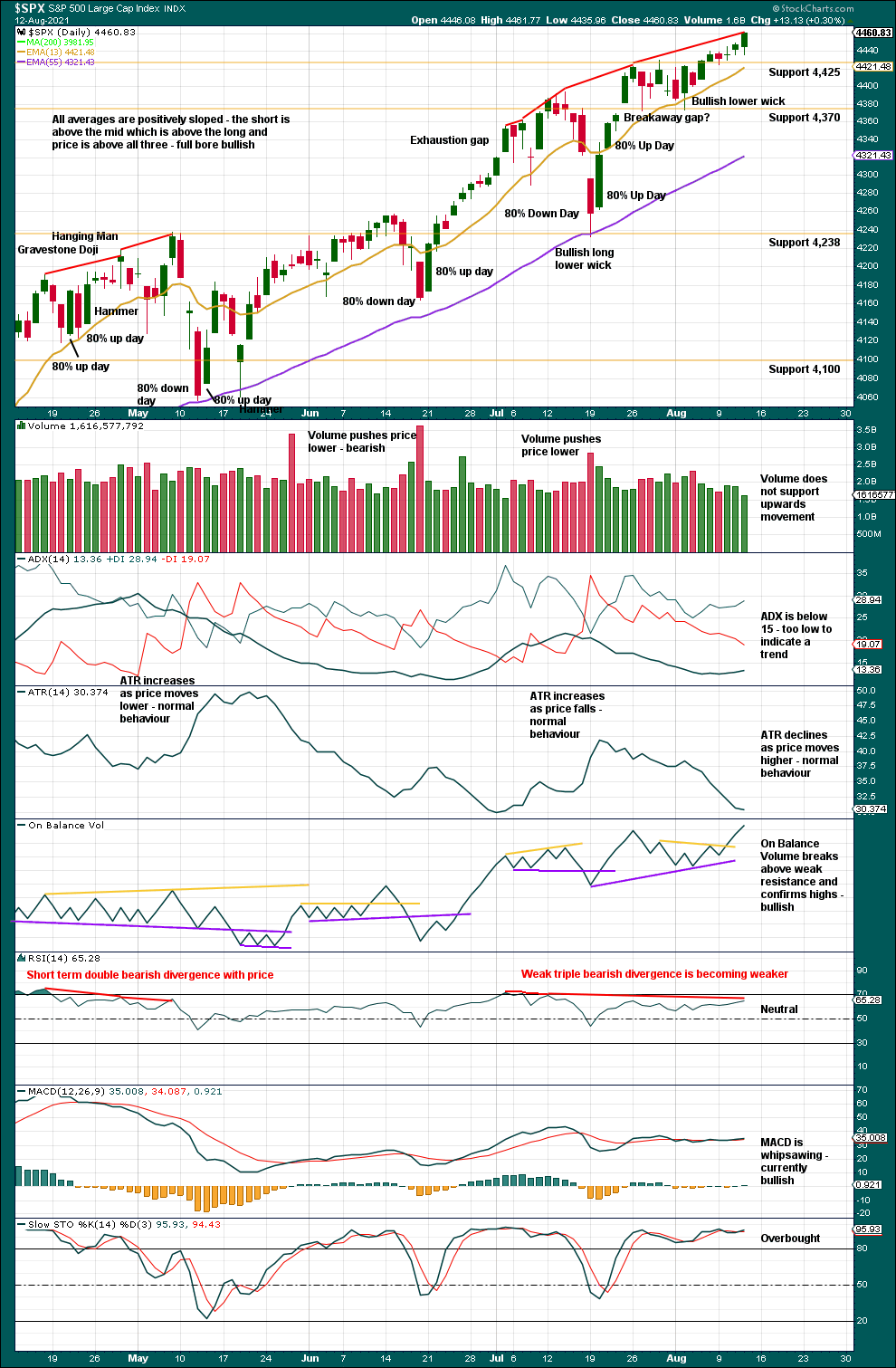
Click chart to enlarge. Chart courtesy of StockCharts.com.
It is possible that the weak short-term bearish divergence between price and RSI up to July 29th has been resolved by a short-term pullback to the low on August 3rd. So far divergence remains, but again today it continues to become weaker. The bullish case in the first alternate wave count is increasing in probability.
It is possible that another consolidation has completed and the bullish trend has resumed. If ADX reaches 15, it would give a strong bullish signal.
BREADTH – AD LINE
WEEKLY CHART
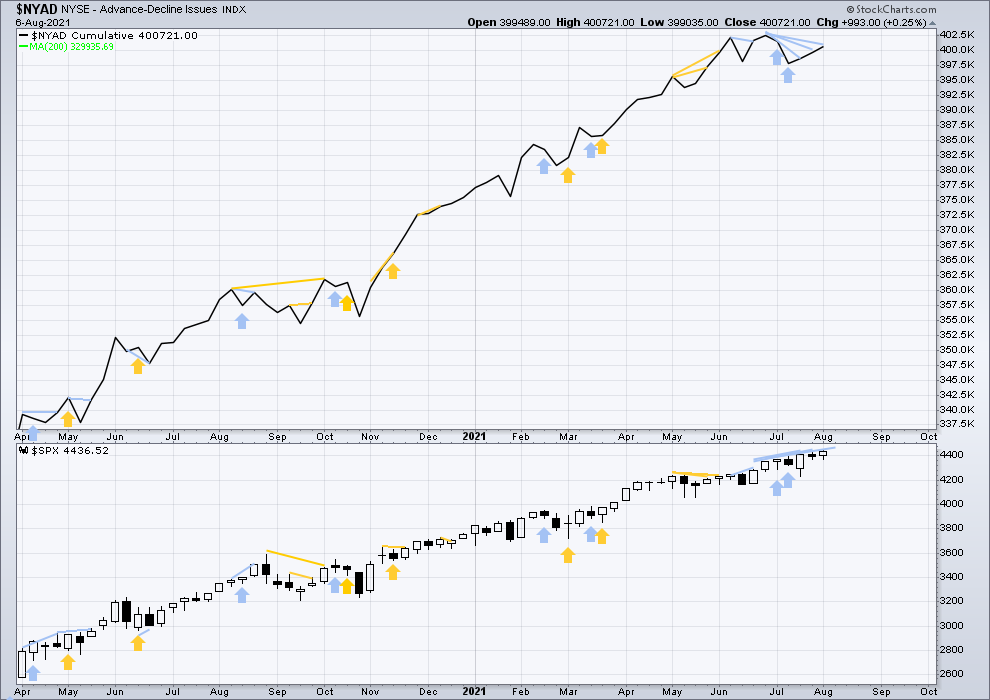
Click chart to enlarge. Chart courtesy of StockCharts.com. So that colour blind members are included, bearish signals will be noted with blue and bullish signals with yellow.
Breadth should be read as a leading indicator.
Lowry’s Operating Companies Only AD line has made a new all time high on the 8th of June. There is now almost two months of bearish divergence between the OCO AD line and price. This supports the main and second alternate Elliott wave counts but not the third alternate Elliott wave count.
There are only 24 sessions of bearish divergence between the NYSE All Issues AD line and price. This supports the main and second alternate Elliott wave counts but not the third alternate Elliott wave count.
Large caps all time high: 4,4461.77 on Aug 12, 2021.
Mid caps all time high: 2,780.08 on May 10, 2021.
Small caps all time high: 1,417.45 on June 8, 2021.
With 3 months of weakness in mid caps and 2 months of weakness in small caps, some pullback or consolidation may result soon.
Price for the third week in a row made a new all time high, but the AD line did not. This adds to the small cluster of bearish divergence and supports the main Elliott wave count.
DAILY CHART
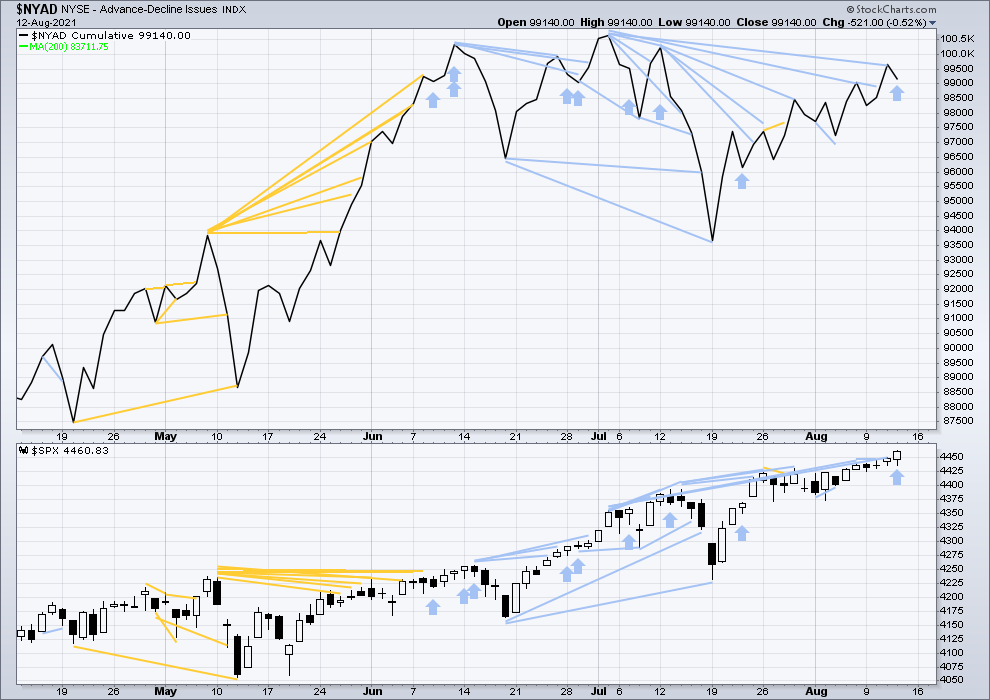
Click chart to enlarge. Chart courtesy of StockCharts.com. So that colour blind members are included, bearish signals will be noted with blue and bullish signals with yellow.
The NYSE All Issues AD line made its last all time high on July 2nd, 2021. There is just over one month of bearish divergence. This suggests the market is currently vulnerable to a short-term pullback within the ongoing upwards trend. This is what the main Elliott wave count expects.
Today price has moved higher, but the AD line has moved lower. Upwards movement today did not have support from rising market breadth. This divergence is bearish and adds to an already reasonable cluster of bearish divergence, which supports the main Elliott wave count.
Today it was large caps which were strongest. This offers slight support to the main Elliott wave count.
VOLATILITY – INVERTED VIX CHART
WEEKLY CHART
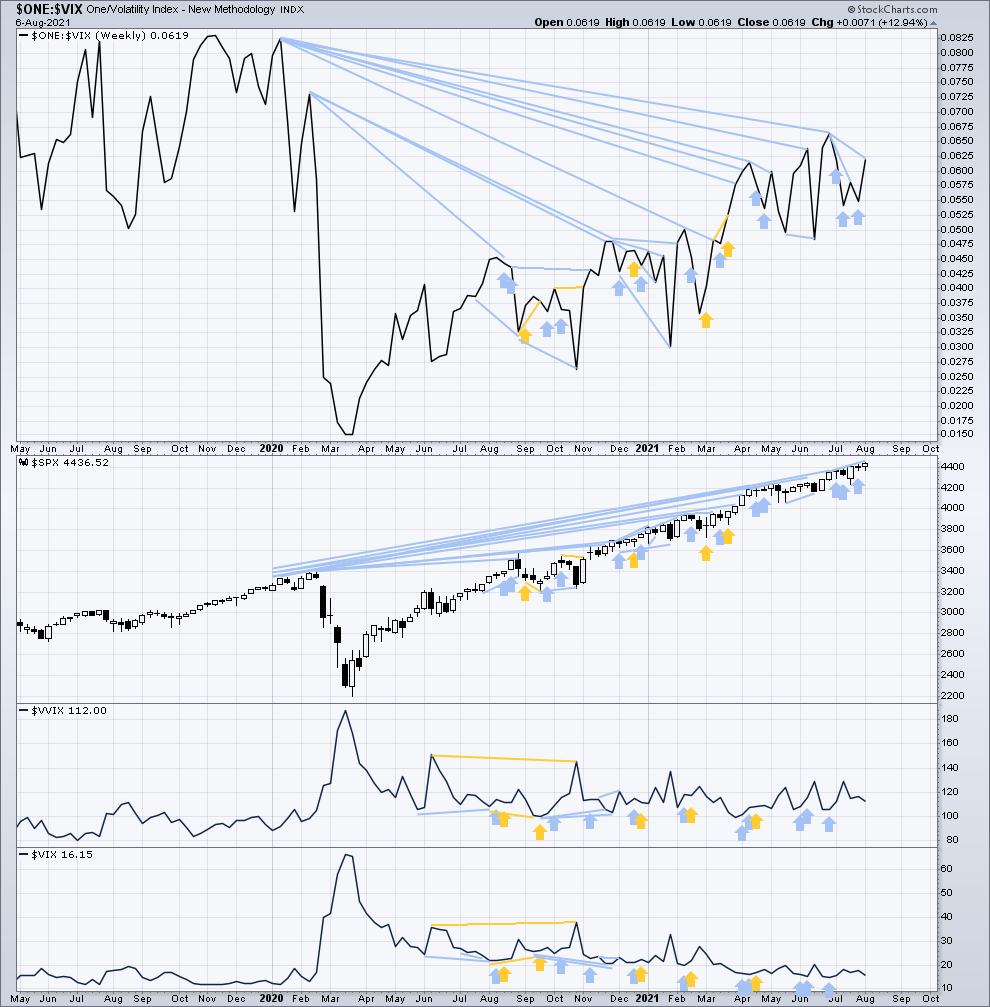
Click chart to enlarge. Chart courtesy of StockCharts.com. So that colour blind members are included, bearish signals will be noted with blue and bullish signals with yellow.
Inverted VIX remains well below all time highs. The all time high for inverted VIX was in the week beginning October 30, 2017. There is over 3 years of bearish divergence between price and inverted VIX. This bearish divergence may develop further before the bull market ends. It may be a very early indicator of an upcoming bear market, but it is not proving to be useful in timing. It may support the third alternate Elliott wave count.
Price and inverted VIX have moved higher last week. Price has made a new all time high, but inverted VIX exhibits all of short, mid and long-term bearish divergence. This supports the main or second alternate Elliott wave counts.
Comparing VIX and VVIX at the weekly chart level:
Both have moved lower. There is no new short-term divergence.
DAILY CHART

Click chart to enlarge. Chart courtesy of StockCharts.com. So that colour blind members are included, bearish signals will be noted with blue and bullish signals with yellow.
Both price and inverted VIX have moved higher again. Price has made a new all time high, but inverted VIX has not made a new short, mid or long-term high. There is again all of short, mid and long-term bearish divergence. This supports the main, second alternate or third alternate Elliott wave counts.
Comparing VIX and VVIX at the daily chart level:
Today both VIX and VVIX have moved lower. There is no new divergence.
DOW THEORY
Dow Theory confirms a new bull market with new highs made on a closing basis:
DJIA: 29,568.57 – closed above on 16th November 2020.
DJT: 11,623.58 – closed above on 7th October 2020.
Most recently, on 10th May 2021 both DJIA and DJT have made new all time highs. An ongoing bull market is again confirmed by Dow Theory.
Adding in the S&P and Nasdaq for an extended Dow Theory, confirmation of a bull market would require new highs made on a closing basis:
S&P500: 3,393.52 – closed above on 21st August 2020.
Nasdaq: 9,838.37 – closed above on June 8, 2020.
The following major swing lows would need to be seen on a closing basis for Dow Theory to confirm a change from bull to a bear market:
DJIA: 18,213.65
DJT: 6,481.20
Adding in the S&P and Nasdaq for an extended Dow Theory, confirmation of a new bear market would require new lows on a closing basis:
S&P500: 2,191.86
Nasdaq: 6,631.42
Published @ 06:37 p.m. ET.
—
Careful risk management protects your trading account(s).
Follow my two Golden Rules:
1. Always trade with stops.
2. Risk only 1-5% of equity on any one trade.
—
New updates to this analysis are in bold.
—


